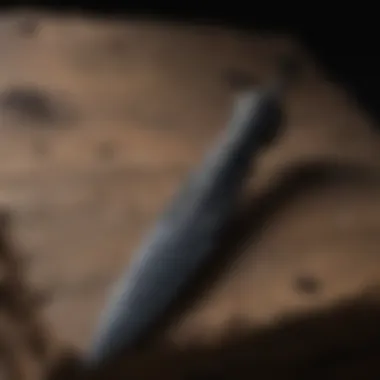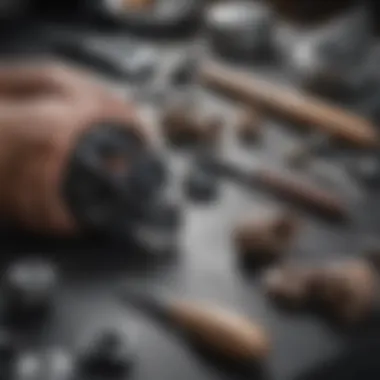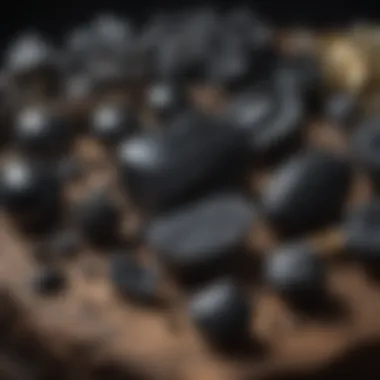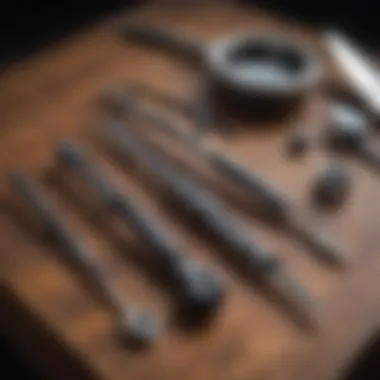Obsidian Surgical Tools: Historical Insights and Modern Use


Intro
Obsidian, a naturally occurring volcanic glass, has carved out a niche in both ancient and modern surgical practices due to its remarkable properties. This article orchestrates a journey through the lens of obsidian surgical tools, unveiling their storied history, multifaceted applications, and rich cultural significance. From ancient civilizations to contemporary medical practices, obsidian's allure continues to enrapture those who explore its depths.
Historically, surgical instruments fashioned from obsidian have demonstrated exceptional sharpness, an attribute that has been beneficial not just for cutting but also for precision in delicate procedures. As we delve into this topic, we will highlight the key elements that underscore the relevance of obsidian tools in modern medicine and their unbreakable ties to cultural heritage.
Through the following sections, we will create a tapestry of knowledge surrounding obsidian tools, revealing how they are intertwined with the evolution of surgical procedures, their modern-day implementations, and the anthropological perspectives they invite.
Join me as we dissect the anatomy of obsidian surgical tools, exploring their journey across time and cultures.
Prelude to Obsidian
Obsidian holds an important place in the history of surgical tools, not only for its practical applications but also for its cultural significance. This section sets the stage for understanding how obsidian, formed from volcanic glass, played a role in ancient medical practices and how its properties have been harnessed over time. The use of obsidian in surgery showcases a fascinating intersection between nature and human ingenuity. It prompts us to appreciate the craftsmanship behind these tools and the insights they offer into our medical history.
Definition and Properties
Obsidian is a naturally occurring volcanic glass created when lava cools quickly. This rapid cooling prevents the formation of crystal structures, resulting in a glassy substance that is smooth and often shiny. Key properties of obsidian include its incredibly sharp edges, which can rival or surpass those of modern steel blades. When meticulously crafted, obsidian tools can achieve an edge sharpness as low as one nanometer.
The material is also lightweight compared to metal, making it easier to handle during surgical procedures. However, it can be brittle, posing challenges in terms of durability. Its distinct properties not only made it suitable for cutting and slicing but also for producing tools that could interact with organic material without causing excessive trauma.
Historical Formation of Obsidian
Historically, obsidian has been used by many cultures around the globe. The formation of obsidian is largely dependent on volcanic activity; thus, its availability varies. In places like central Mexico, obsidian was abundant and highly valued. Archaeological evidence indicates that the ancient Aztecs utilized obsidian for both weaponry and surgical implements, reflecting their understanding of its effectiveness.
In areas where obsidian was scarce, it was traded extensively, indicating its significance in medical practices and day-to-day life. The knowledge of sourcing and crafting obsidian tools speaks volumes about the ingenuity of these ancient societies. Sites across the Mediterranean, as well as in the Americas and the Pacific Islands, have shown that these pieces were not just tools but also works of art, with intricate designs that demonstrate both skill and aesthetic consideration.
As we delve deeper into the application of obsidian tools in medicine, it becomes clear that their historical significance is underscored by a blend of practical necessity and cultural values. The study of these tools offers insights into how ancient civilizations approached health and healing.
The Use of Obsidian in Ancient Surgery
The role of obsidian in ancient surgical practices cannot be overstated. This natural volcanic glass, with its sharp edges and unique properties, was not merely a tool but a cornerstone of medical practices in early civilizations. Understanding the significance of obsidian in these contexts provides insights not only into the technological advancements of the time but also into the cultural frameworks surrounding healthcare and healing.
Early Civilizations and Medical Practices
Histories from various regions showcase how societies used obsidian for surgical procedures, revealing their creativity in tool-making and their understanding of human anatomy. For instance, in Mesoamerica, the Aztecs and Mayans harnessed the sharpness of obsidian for diverse medical applications. They crafted scalpels that could perform precursory surgeries, from simple lancing to more profound dissections. The effectiveness of these tools in minimizing trauma during surgery evidences a sophisticated grasp of the human body as well as the needs of patients.
Obsidian's popularity extended far beyond a mere commodity; it was woven into the fabric of healing practices. Shamans and healers often employed these tools in ritualistic contexts, believed to harness the stone's power not just for physical healing but also for spiritual cleansing. This blend of practicality with spirituality accentuates the multifaceted nature of obsidian in historical healing practices.
Notable Archaeological Findings
Archaeological digs have unearthed a treasure trove of obsidian tools, shedding light on their use and significance among ancient societies. In places like the Teotihuacan Valley, surgeons have found comprehensive toolkits with various obsidian implements, each designed for specific surgical tasks, some honed to surgical precision.
In addition, discoveries at burial sites indicate that obsidian tools were often laid with the deceased, suggesting a belief system that regarded these tools as essential for the afterlife. For instance, sites discovered in what is modern-day Peru included obsidian-headed scalpels placed alongside ancient mummies, creating a vivid picture of how deeply rooted these tools were in cultural practices.
"The obsidian tool is a symbol of precision and skill; its history reflects not just medical advances but also a narrative of culture and belief."


As research continues, each new find strengthens the connection between obsidian and the evolution of medical practices throughout ancient history, revealing a complex narrative that intertwines technology, culture, and spirituality. The findings emphasize how these tools were indispensable for surgeons and how the culture surrounding them greatly influenced their use. Understanding this legacy is crucial for grasping how modern medicine draws from its historical roots.
Material Properties of Obsidian Surgical Tools
Understanding the material properties of obsidian surgical tools is crucial for grasping both their historical relevance and their modern applications. Obsidian, a naturally occurring volcanic glass formed when lava cools rapidly, boasts unique characteristics that set it apart from traditional surgical materials. Its use in healthcare, although ancient, is being revisited in contemporary settings. This section explores two key attributes: sharpness and edge retention, along with biocompatibility and sterilization concerns.
Sharpness and Edge Retention
One of the standout features of obsidian tools is their extraordinary sharpness. When fashioned into surgical instruments, obsidian blades can achieve an edge that is much sharper than their metal counterparts. This razor-like sharpness comes from its glassy structure. The fracture planes of obsidian are incredibly fine, which means a blade created from obsidian can slice through tissue with minimal pressure. This less invasive approach could potentially lead to reduced scarring and faster healing times.
However, sharpness alone doesn't tell the whole story. The edge retention of obsidian is another crucial factor that cannot be overlooked. While obsidian can maintain a sharp edge longer than many metals in various applications, it does tend to dull more quickly in consistent surgical use. The nature of the material means that even slight impact can chip or break the blade, rendering it ineffective for precise procedures. Thus, while surgeons can benefit from its initial sharpness, they must be mindful of the potential need for more frequent replacements or re-edging.
"The ancient healers knew the value of a sharp blade; it made all the difference between precision and peril."
In a surgical context, having a reliable and consistent tool is paramount. This challenge has prompted modern researchers to explore coatings or treatments that could enhance the durability of obsidian blades while still preserving their original benefits. Striking a balance between maintaining the exceptional sharpness of obsidian and its functional lifespan remains a vital area of research.
Biocompatibility and Sterilization Concerns
The biocompatibility of surgical tools is an essential consideration, especially for those that come into contact with living tissues. Obsidian is known for being more biocompatible than some materials, as it does not generate a significant immune response when implanted or used on the body. This aspect is advantageous for surgical applications, especially in procedures where cutting through delicate tissues is involved.
Yet, there are sterilization concerns that practitioners must address. Unlike metals, obsidian can be more prone to damage during traditional sterilization processes like autoclaving. The intense heat and pressure can weaken the structure or even shatter the blade. Thus, alternative sterilization methods must be evaluated. Chemical sterilization is often discussed among professionals as a viable option, but this also raises questions about any potential chemical residue that might remain on the blade.
Moreover, understanding how obsidian interacts with bodily fluids is critical. Studies have suggested that when obsidian tools are properly maintained, they can minimize risks of infection, making them a potentially valuable option in certain surgeries.
In summary, while obsidian surgical tools present remarkable advantages in terms of sharpness and biocompatibility, they also come with their fair share of challenges. Addressing these challenges through research and innovation will help determine the future role of obsidian in modern healthcare.
Modern Applications of Obsidian Tools
The rising interest in obsidian surgical tools sheds light on their relevance in modern medicine. While metal instruments dominate hospitals today, obsidian's unique characteristics present a compelling case for their application in contemporary surgical procedures. It's not just about the historical connection to ancient practices; obsidian tools offer particular benefits that can enhance surgical outcomes. Understanding these modern applications helps to bridge the gap between the past and present, revealing obsidian's continued significance in medicine.
Current Surgical Techniques Using Obsidian
In recent years, researchers and practitioners have revisited the efficacy of obsidian in surgeries. Modern surgical techniques that incorporate obsidian tools often focus on minimally invasive procedures. One notable area is in ophthalmic surgery, where the precision of obsidian blades may lead to reduced trauma for patients. These tools can achieve finer incisions compared to standard stainless steel, crucial when operating on sensitive ocular tissues.
"The sharpness of obsidian enables surgeons to perform delicate tasks that metal tools cannot achieve with the same level of accuracy."
Additionally, its application has found a foothold in plastic surgery, particularly in procedures requiring precision and minimal scarring. Surgeons using obsidian claim that not only do these tools provide an exceptionally sharp edge but they also allow for smoother incisions, potentially leading to faster recovery times for patients.
Comparative Analysis with Metal Surgical Tools
When analyzing obsidian tools against their metal counterparts, several factors come into play. First, sharpness is a major distinguishing feature. Obsidian instruments can maintain a sharper edge longer than metal knives, resulting in cleaner cuts. This sharpness is critical in medical environments where precision is paramount.
However, there are challenges. While obsidian offers remarkable sharpness, they are also more fragile than metal tools. This fragility can limit their usage in certain surgical environments — sharp tools that can shatter could pose greater risk in high-stress operations. Metal instruments, especially those made of titanium or stainless steel, tend to offer greater durability and robustness.
The biocompatibility of obsidian is another point of comparison. Obsidian is known for its inert properties, which means it's less likely to react negatively with human tissue. In contrast, some metal tools can carry a risk of allergic reactions or infections, complicating patient recovery.


Cultural Perspectives on Obsidian
Understanding the cultural implications of obsidian transcends its material qualities and surgical applications. It delves into the practices and beliefs that have shaped its usage among various communities, revealing how a geological formation has influenced not just medicine, but also social and spiritual dynamics throughout history.
Obsidian in Indigenous Medical Practices
For many indigenous cultures, obsidian was more than just a tool; it was a symbol embedded in their medical practice. In various regions, particularly in Mesoamerica, the use of obsidian for surgical applications was interwined with traditional healing. Techniques involving obsidian blades were often conducted within ceremonial contexts, further emphasizing the material's importance. Healing rituals, some of which date back thousands of years, show that obsidian's clarity and sharpness were not only chosen for their practicality but were also believed to wield spiritual significance.
The Tzeltal Maya in Chiapas, Mexico, are a prime example of this connection. They utilized obsidian scalpels not only to perform physical procedures but within a framework of belief that included the sight of the sharp edge as a way of cutting mal de ojo, or the evil eye. The obsidian tools served a dual purpose: as efficient surgical instruments and as conduits for spiritual healing.
Other indigenous tribes throughout North America also shared similar practices. The Miwok, for instance, incorporated obsidian tools into their healing arts while performing rituals intended to enhance the efficacy of the surgery. The respect for these tools in medical contexts illustrates how obsidian was more than a means to an end; it represented a deep-seated connection to nature and the belief systems that surrounded it.
Symbolism and Spiritual Significance
The symbolism of obsidian stretches far beyond its tangible nature. Within many cultures, obsidian is viewed as a potent stone, commonly associated with the underworld, protection, and spiritual insight. Its smooth, glassy surface evokes thoughts of depth and the chasms of time, entwining it with notions of introspection and the unseen.
In the traditional beliefs of the Inca, obsidian held a certain reverence, often used in their spiritual rituals. It was thought to ward off negative energies, making it an essential tool in both daily life and ceremonial settings. When wielding an obsidian knife, the practitioners believed it provided a link between the earthly and the spiritual realms, channeling physical and metaphysical energies during surgical or healing practices.
"Obsidian, with its reflective surface, invites introspection and awareness of one's deeper self."
The spiritual significance attributed to obsidian is also echoed in the tales of various tribes where it is often symbolized as a shield against harm. This illustrates how obsidian was not merely utilized in a medical capacity but also acted as a protective talisman, embodying the dual nature of the stone—both a tool for healing and a means to fend off malevolent forces.
In summary, the cultural perspectives surrounding obsidian reflect its broader significance in human history. Its role in indigenous medical practices is indicative not just of its physical properties but also of the multidisciplinary worldviews of those who wielded it. From the ritualistic surgeries to its symbolism as a guardian stone, obsidian melds science with spirituality in ways that resonate deeply across time and cultures.
Challenges and Risks Associated with Obsidian Tools
The use of obsidian surgical tools comes with a number of important challenges and risks that need careful consideration. Understanding these factors is vital, not just for medical professionals but for enthusiasts who dissect the intersection of culture and technology. While obsidian has historical significance, its application in modern medicine raises questions surrounding safety, efficacy, and regulatory compliance.
Potential Hazards in Surgical Settings
Working with obsidian surgical tools involves unique risks. The material, while extremely sharp, is also incredibly brittle. This brittleness can potentially lead to tool breaking during a procedure. Such failure might expose patients to sharp shards, increasing the risk of injury instead of facilitating a smoother operation.
Moreover, the precision of obsidian tools means that any inadvertent movement might lead to unexpected damage within delicate tissues during surgery. This can complicate recovery for patients, resulting in extended hospital stays or even worse outcomes.
The handling of obsidian tools also presents hazards for the surgical team themselves. Accidental self-inflicted wounds could be a very real risk, posing an ironic twist in a field that relies heavily on precision and safety. It’s crucial for surgical teams to undergo comprehensive training to develop the skills necessary to use these tools properly and safely.
Investing time in understanding the unique properties of obsidian and conducting simulations can be pivotal in minimizing such risks.
Legal and Ethical Considerations
As we venture further into the application of obsidian in contemporary practices, the legal landscape surrounding its use cannot be ignored. One major concern is the regulatory oversight applicable to surgical tools, including those made of obsidian. In many jurisdictions, medical devices must be tested and approved to ensure their safety and efficacy before being used in surgical settings. Obsidian tools, being somewhat niche and less understood, may not easily fall under existing regulations.
Furthermore, ethical dilemmas arise concerning informed consent. Patients need to be fully aware of the materials being used in their surgical procedures, particularly when it comes to alternative materials like obsidian, which may not be as widely accepted or understood compared to traditional metal tools.
Healthcare providers must navigate this complex landscape, ensuring they are compliant with the law while also offering patients transparency about the types of tools that will be used. It is imperative for surgical teams to keep abreast of existing laws and to consider how evolving practices can align with ethical responsibilities.


Overall, grappling with these challenges and potential hazards requires not only a deep understanding of obsidian's physical characteristics but also a strong ethical framework to guide its application in modern medicine.
Innovations in Obsidian Surgical Technologies
The journey of obsidian surgical tools has reached a pinnacle of innovation. Recent advancements highlight not only the enduring importance of these tools but also their growing relevance in modern healthcare. Innovations in obsidian surgical technologies embody several elements that are crucial for surgical efficiency and patient safety.
Recent Research and Developments
The realm of obsidian research is vibrant, with scientists integrating historical knowledge with cutting-edge technology. Recent studies have looked into the manufacturing processes of obsidian tools, focusing on methods to enhance their strength and sharpness. For instance, researchers at the University of California have demonstrated that modern techniques can create surgical blades with edges finer than those made in ancient times, allowing for precision cuts that minimize tissue damage.
As obsidian is predominantly silica-based, its structure allows for high-quality edge retention. This unique property is being exploited in laboratory settings to create blades that remain sharper longer compared to stainless steel alternatives. A pivotal paper published in Materials Science and Engineering suggests that with proper treatment, obsidian's fragility can be mitigated, making it suitable for various medical applications beyond surgical knives, such as scalpel handles and specialized tools for delicate procedures.
Moreover, the recent research on obsidian’s tensile strength sheds light on potential new applications. For example, combining obsidian with modern composites could lead to revolutionary tools that harness both durability and the inherent sharpness of obsidian.
“The ability to develop obsidian tools that challenge the standards of modern metallic alternatives has made obsidian a subject of intense research.”
This inclination towards innovating ancient materials pairs well with an increasing interest in sustainability in medicine. Obsidian, being a natural volcanic glass, offers an eco-friendly alternative to synthetic materials often used in surgical tools.
Integration with Modern Medicine
The integration of obsidian surgical tools into modern medicine isn't merely about using old materials in new procedures; it requires understanding and adapting these tools to fit contemporary medical practices. Surgeons and researchers are engaging in a collaborative effort to test the effectiveness of obsidian within various surgical contexts.
Current applications are being explored in minimally invasive surgeries, where precision is paramount. The sharpness of obsidian blades allows for less tissue trauma, which is highly valued in surgeries that demand small incisions. Many studies indicate that using obsidian tools may lead to faster recovery times and reduced complications, a claim that brings credibility to these ancient methods in a modern setting.
Training programs for surgeons are now incorporating obsidian tools into their curriculum. The objective is to familiarize healthcare professionals with the unique handling and cutting characteristics of obsidian, ensuring they can integrate these tools effectively into their practices. Feedback from practitioners has indicated a growing appreciation for the tactile feedback and control offered by obsidian, adding to its appeal as a surgical choice.
As innovations continue to unfold, the cultural significance of obsidian cannot be overlooked. From being pivotal to ancient medical practices to re-emerging as a frontrunner in modern surgical advancements, obsidian surgical tools are bridging the gap between history and future. They serve as a constant reminder that sometimes looking back can propel us forward.
The End: The Relevance of Obsidian Today
Obsidian surgical tools hold a unique place in both historical and modern contexts. Recognizing their relevance today requires an in-depth understanding of not just their physical properties but their cultural and medical implications. As we reflect on obsidian's journey from ancient surgical implements to contemporary research subjects, we find a fascinating interplay of science, tradition, and innovation.
One critical aspect is the continuation of traditional practices in modern healthcare settings. While metal tools dominate, there’s a renewed interest in incorporating obsidian due to its remarkable sharpness and biocompatibility. These qualities make obsidian not only effective for precise incisions but also a potential option for minimally invasive procedures.
"Obsidian offers a connection between our past medicinal practices and future innovations in surgery."
Furthermore, the cultural significance of obsidian adds depth to its relevance. In numerous indigenous cultures, obsidian is seen as a tool not just for surgery but for healing and spirituality. Its rich historical tapestry continues to influence modern practices, making obsidian a source of both aesthetic appreciation and functional application.
As we proceed further, the intersection of technology and tradition is becoming more pronounced. The awareness and curiosity surrounding obsidian tools highlight their potential in not just familiar medical practices but also in emerging fields such as biotechnology and sustainable practices in medicine. Therefore, it is vital to appreciate obsidian for more than just its physical properties; it embodies a legacy that resonates through time, bridging ancient wisdom and modern techniques.
Summary of Key Points
To encapsulate the discussion, here are the pivotal elements highlighted throughout:
- Historical Legacy: Obsidian’s use in ancient surgeries, showcasing the foundational role of these tools in early medical practices.
- Material Properties: The inherent qualities of obsidian, including sharpness, edge retention, and biocompatibility, which advocate for its use in modern surgical settings.
- Cultural Relevance: The significance of obsidian in various cultures contributes to its understanding as more than a mere tool but a symbol of healing and connection.
- Current Innovations: Ongoing research indicates a resurgence of interest in obsidian for its potential roles in contemporary surgeries and its integration into evolving medical technologies.
Future Directions for Research
Looking ahead, the exploration of obsidian surgical tools seems promising and multifaceted. Here are some avenues for future consideration:
- Refinement and Improvement: There is potential to develop improved techniques for crafting obsidian tools, enhancing their durability and versatility in surgical applications.
- Comparative Studies: Future research could benefit from comparative studies between obsidian and emerging materials in surgery, examining efficacy, safety, and practicality in real-time clinical settings.
- Cultural Studies: Delving deeper into the cultural significances across different societies may lead to richer insights into how modern medicine can blend with indigenous knowledge.
- Technological Integration: Investigating how obsidian can be integrated with digital technologies, including advancements in surgical robotics, might open doors to revolutionary approaches in precision surgery.







